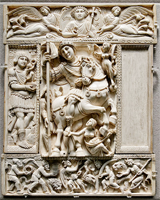
This page created 9 April 2014, and last modified: 30 November 2014 (Maier reference numbers added)

The Sagittarii seniores Gallicani is the 6th unit of auxilia palatina listed (9.29 in Ingo Maier's numbering scheme) under the command of the first Master of the Soldiers in the Imperial Presence (i.e. the Magister Militum Praesentalis I). Its shield pattern (8#4) as shown in various manuscripts, under the matching label (8.d) Sagittarii seniores Gallicani, is as below:

Note that in both M and W the shield label (but not the list entry) actually says Sagittarii iuniores Gallicani, which is the next unit listed, and which is correctly labelled. The shield pattern, showing a pair of winged Victories flanking what appears to be an image of an imperial couple (albeit with the Victories either absent (M) or (W, B) interpreted as eagles), is very similar to that of the Sagittarii iuniores Gallicani, as the following patterns taken from the Paris manuscript should help to illustrate (except the middle one, which is taken from the Froben edition; the reasons for which are to be found here):

Clearly, these two units are not only a related pair, but are also related to other Sagittarii units under the the command of the second Master of the Soldiers in the Imperial Presence. Interestingly, two other eastern units show similar paired Victories: the Domestici equites and the Domestici pedites, under the commands of the Count of the Household Horse and Count of the Household Foot, respectively.
Paired Victories flanking an imperial image are a characteristic late Roman motif, and can also be found on. e.g. the Arch of Constantine (although in this case the imperial image has been lost, and single Victories are also used on the same monument). The motif continued into the Byzantine era; the picture below of the early-6th century Barberini ivory in the Louvre shows how the Victories have been transformed into angels, and are now elevated to flanking Christ rather than the earthly emperor.

Photo by Marie-Lan Nguyen and released into the public domain.
The name Sagittarii seniores Gallicani implies (but does not establish) the unit was bow-armed, and that it was recruited or otherwise came from somewhere in Gaul.

Return to the Notitia alphabetical unit list page.
Return to my Notitia index page.